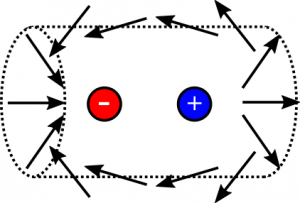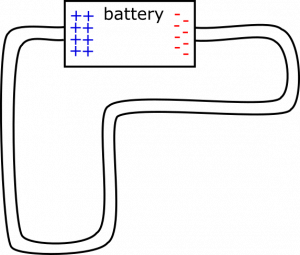This is an old revision of the document!
Example: Charge Distribution on the Bends of a Circuit
On the circuit shown below, draw how you would expect charge to distribute on the surface of the wire near the bends in the circuit.
Facts
- Electric field is constant in the wire.
- Electric field points along the direction of the wire, from positive to negative.
- Charges can build up on the surface of the wire.
Lacking
- Charge distribution near the bends in the wire.
Approximations & Assumptions
- There are no external electric fields.
Representations
- We represent the circuit as in the example statement above.
- We will represent the charge distribution with little pluses ($+$) and minuses ($-$).
Solution
First, notice that we probably do not want to do any calculations here, since the it will not be fun to take a dot-product of the dipole's electric field and the area-vector, and it will get very messy very quickly when we start integrating over the surface of the cylinder. Instead, we evaluate the situation more qualitatively. Consider the electric field vectors of the dipole near the surface of the cylinder:

Notice that the vectors near the positive charge are leaving the cylinder, and the vectors near the negative charge are entering. Not only this, but they are mirror images of each other. Wherever an electric field vector points out of the cylinder on the right side, there is another electric field vector on the left that is pointing into the cylinder at the same angle. These mirror image vectors also have the same magnitude, though it is a little tougher to visualize.
We could write this as a comparison between the left and right side of the cylinder. The $\text{d}\vec{A}$-vectors are mirrored for left vs. right, and the $\vec{E}$-vectors are mirrored, but opposite $\left(\vec{E}_{left}=-\vec{E}_{right}\right)$. We tentatively write the equality, $$\Phi_{left}=-\Phi_{right}$$
Putting it together, we tentatively write: $$\Phi_{\text{cylinder}}=\Phi_{left}+\Phi_{right}=0$$ We gain more confidence when we read the next section of notes, where we define “Gauss' Law”. This law states that the total flux through a close surface is the amount of charge enclosed divided by $\epsilon_0$, the permittivity of free space. $$\Phi_{\text{total}}=\int \vec{E} \cdot \text{d}\vec{A}=\frac{Q_{\text{enclosed}}}{\epsilon_0}$$ Since the total charge of the dipole is $0$, then indeed the charge enclosed is $0$, and we were correct with our reasoning about the electric field and flux above.
